Saturday, April 10, 2021
Salute to Benjn Pike Jr part 3: Spectacles
[Following from part 1 and part 2.]
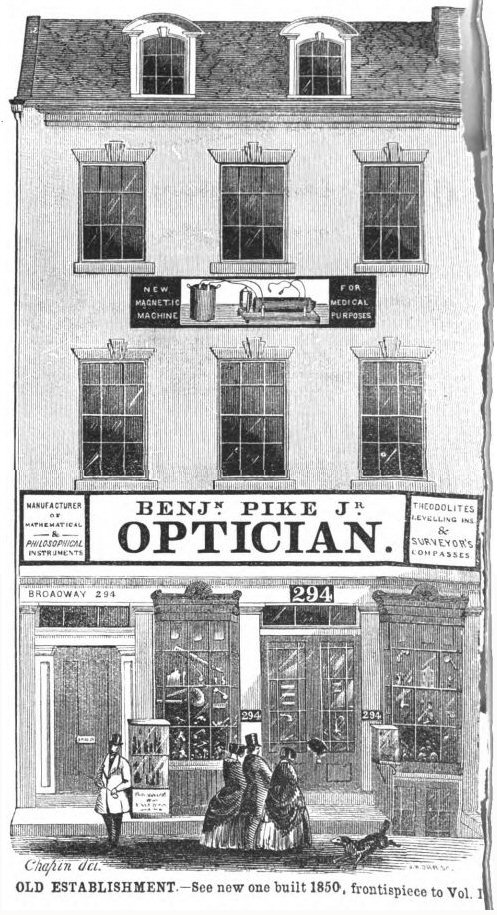 Benjn Pike Jr was mainly an optical manufacturer. In this section I'll focus on the optical side of his 1848 catalog, which contained spectacles with sliding parts and spectacles with sliding parts.
= = = = =
First the product you expect from an optician: eyeglasses. These had sliding bows, common at that time, so you could adjust each side for comfort or focus.
A lost feature. Why was it lost? Deskilling. Offshoring. Every branch of medicine and life has been yanking functions and skills away from normal people and reserving the functions for specialists or foreigners. Only professional opticians are allowed to adjust glasses, and after adjustment there are no user-serviceable parts.
Benjn Pike Jr was mainly an optical manufacturer. In this section I'll focus on the optical side of his 1848 catalog, which contained spectacles with sliding parts and spectacles with sliding parts.
= = = = =
First the product you expect from an optician: eyeglasses. These had sliding bows, common at that time, so you could adjust each side for comfort or focus.
A lost feature. Why was it lost? Deskilling. Offshoring. Every branch of medicine and life has been yanking functions and skills away from normal people and reserving the functions for specialists or foreigners. Only professional opticians are allowed to adjust glasses, and after adjustment there are no user-serviceable parts.
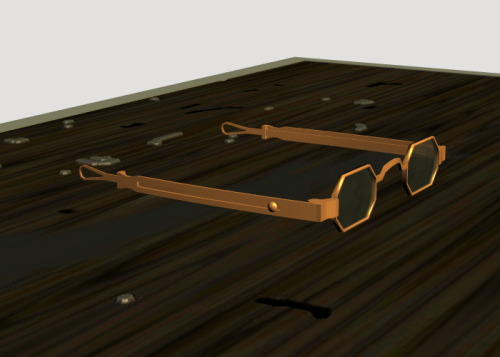 = = = = =
The other type of spectacle with sliding parts shows the interface of science AND education AND entertainment.
The Magic Lantern.
I had thought the magic lantern was just a slide projector with light furnished by flame instead of electricity. The machine was partly similar, but the ACTUAL USE of the magic lantern before 1900 was interactive and animated, unlike both slides and cinema.
The key to a good magic lantern spectacle was in the slideRs, which were NOT the same thing as slides.
Closeup view of a lantern with a typical slideR mechanism:
= = = = =
The other type of spectacle with sliding parts shows the interface of science AND education AND entertainment.
The Magic Lantern.
I had thought the magic lantern was just a slide projector with light furnished by flame instead of electricity. The machine was partly similar, but the ACTUAL USE of the magic lantern before 1900 was interactive and animated, unlike both slides and cinema.
The key to a good magic lantern spectacle was in the slideRs, which were NOT the same thing as slides.
Closeup view of a lantern with a typical slideR mechanism:
 The lamp (alcohol or whale oil) was focused by the mirror in back. The tiny cranks drove a miniature conveyor belt, making it possible to move one slider back and forth, or move one smaller slider across a bigger one.
Here the fixed slider is Polistra's home, and the movable slider is HappySun moving across the horizon.
The lamp (alcohol or whale oil) was focused by the mirror in back. The tiny cranks drove a miniature conveyor belt, making it possible to move one slider back and forth, or move one smaller slider across a bigger one.
Here the fixed slider is Polistra's home, and the movable slider is HappySun moving across the horizon.
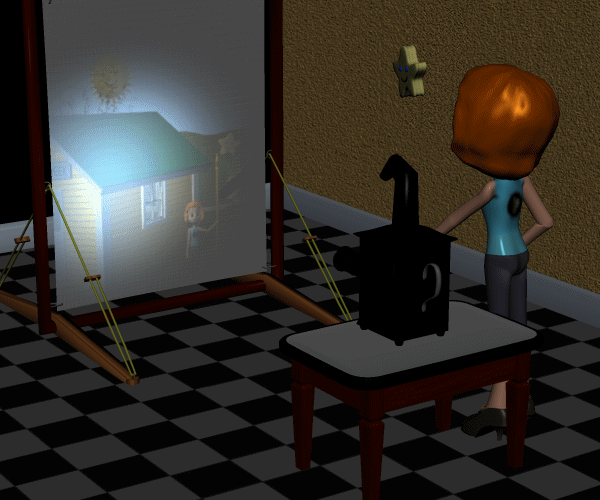 Another way of animating was the dissolver, a pair of lanterns with a mechanism to gradually hide one and display the other. I'm trying to do a ticking pendulum here, but the dissolver doesn't work well in the Poser digital setup because Poser doesn't have real lenses and doesn't merge the images properly.
Another way of animating was the dissolver, a pair of lanterns with a mechanism to gradually hide one and display the other. I'm trying to do a ticking pendulum here, but the dissolver doesn't work well in the Poser digital setup because Poser doesn't have real lenses and doesn't merge the images properly.
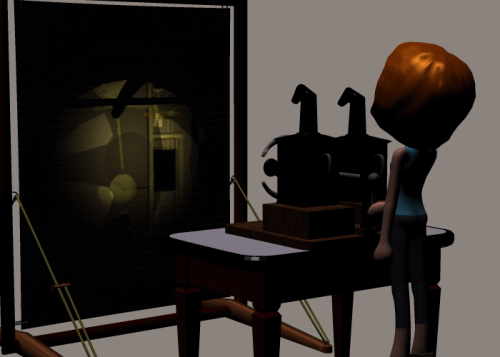 Sliding and dissolving animations were highly developed in 1850. Many other variations were available, including miniature silhouette figures that danced when you turned the crank. These were about 3 inches high, packing a lot of mechanism into a small space.
Sliding and dissolving animations were highly developed in 1850. Many other variations were available, including miniature silhouette figures that danced when you turned the crank. These were about 3 inches high, packing a lot of mechanism into a small space.
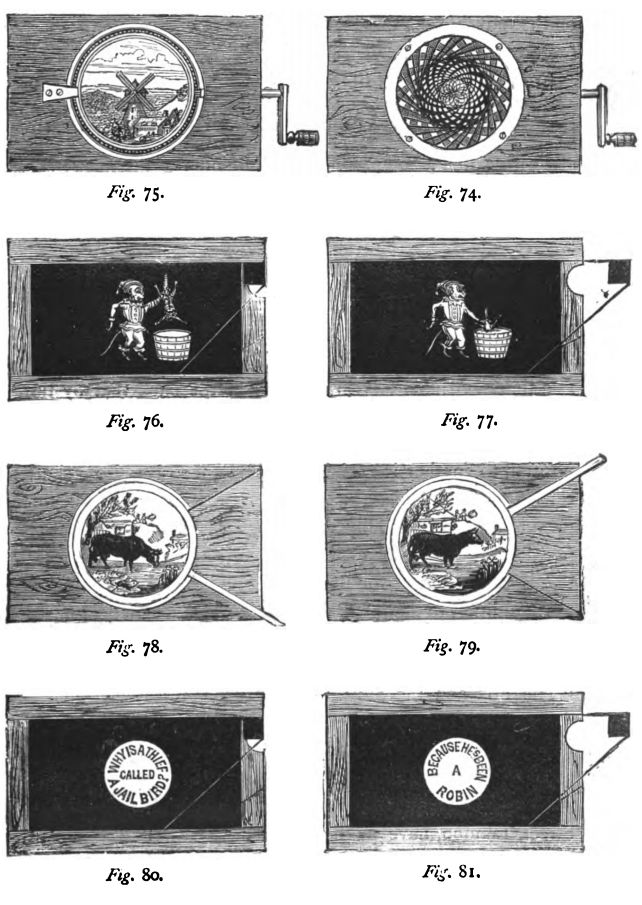 Some were intended solely for amusement:
Some were intended solely for amusement:
 We know what French means, don't we? Wink, wink, nudge, nudge.
Others were more educational:
We know what French means, don't we? Wink, wink, nudge, nudge.
Others were more educational:
 Cinema later redeveloped similar techniques, BUT they weren't interactive, weren't user-serviceable. Hollywood editors performed the dissolves and animation, then packaged them as unchangeable and uncontrollable sequences. In the 1950s every school had a slide projector for stiff unchanging slides, and a filmstrip projector with a similar rack-type mechanism used only for advancing to the next rigid picture.
Cinema later redeveloped similar techniques, BUT they weren't interactive, weren't user-serviceable. Hollywood editors performed the dissolves and animation, then packaged them as unchangeable and uncontrollable sequences. In the 1950s every school had a slide projector for stiff unchanging slides, and a filmstrip projector with a similar rack-type mechanism used only for advancing to the next rigid picture.
 The mechanism was the same, only the techniques and the magic were gone.
A similar process of centralization and deskilling happened in the digital era. The early PCs, especially Amiga, had plenty of DIY animation available. Windows EXEs could perform similar tricks, and I used those tricks in my early courseware to create interactive experiments. After everything moved online, the tricks were much harder to accomplish. I had to remake my "live" interactive animations as uncontrollable sequences of frames, just like the change from slideRs to slides.
In fairness, slider and dissolver techniques are available in SVG controlled by JS, but they're not used for animation. Dissolvers are only used by paywalls to show you a fading-out version of the page before you pay. User-controlled sliders remain in one specialized vestigial situation: Then vs Now pictures of cityscapes.
= = = = =
The Scientific Lantern is the real interface point of magic and entertainment and science. Magic shows and science shows were the same thing. Serious scientists like Faraday enjoyed creating stage spectacles to illustrate the devices and principles they were developing.
This Scientific Lantern has the lamp as above, but instead of sliders it has a big space between lamp and lens where you could mount various kinds of experiments and displays.
The mechanism was the same, only the techniques and the magic were gone.
A similar process of centralization and deskilling happened in the digital era. The early PCs, especially Amiga, had plenty of DIY animation available. Windows EXEs could perform similar tricks, and I used those tricks in my early courseware to create interactive experiments. After everything moved online, the tricks were much harder to accomplish. I had to remake my "live" interactive animations as uncontrollable sequences of frames, just like the change from slideRs to slides.
In fairness, slider and dissolver techniques are available in SVG controlled by JS, but they're not used for animation. Dissolvers are only used by paywalls to show you a fading-out version of the page before you pay. User-controlled sliders remain in one specialized vestigial situation: Then vs Now pictures of cityscapes.
= = = = =
The Scientific Lantern is the real interface point of magic and entertainment and science. Magic shows and science shows were the same thing. Serious scientists like Faraday enjoyed creating stage spectacles to illustrate the devices and principles they were developing.
This Scientific Lantern has the lamp as above, but instead of sliders it has a big space between lamp and lens where you could mount various kinds of experiments and displays.
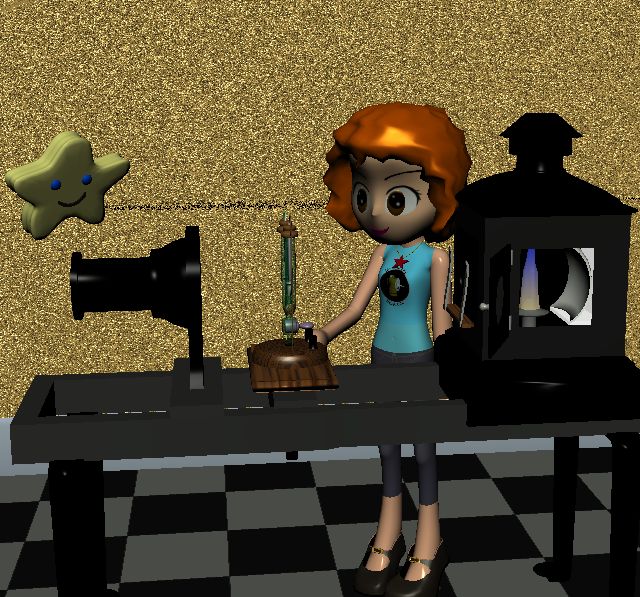 Here the target is a conductivity cell, which would be part of a full experimental setup like this:
Here the target is a conductivity cell, which would be part of a full experimental setup like this:
 The bubbles and reactions in the cell would be visible to the audience.
The platform in the Scientific Lantern could also hold an aquarium or terrarium with critters, preferably transparent or translucent critters.
The bubbles and reactions in the cell would be visible to the audience.
The platform in the Scientific Lantern could also hold an aquarium or terrarium with critters, preferably transparent or translucent critters.
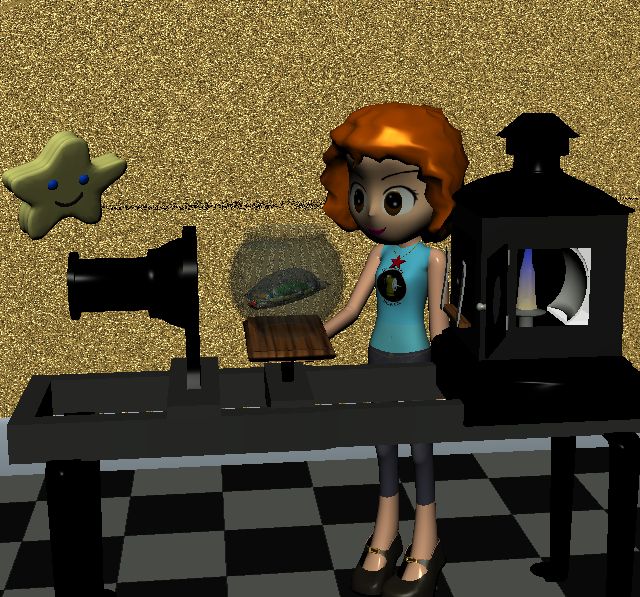 = = = = =
Along with the loss of interactivity, there's a MUCH BIGGER moral to this story. When science was a form of entertainment, everyone could see and ENJOY the actual process of observation and experimentation. When science had user-serviceable parts, everyone could participate in science.
In 1946 science merged with Deepstate and became a tool of surveillance and genocide. We are no longer allowed to see how science works. We no longer get to hear or participate in open descriptions and discussions. Nothing leaks out, nothing is ever displayed or revealed.
We only get to experience the massively evil and demonic ACTIONS of science when it imprisons and binds and gags and kills us by the millions.
ENTERTAINMENT IS THE OPPOSITE OF SECRETS.
ENTERTAINMENT IS THE OPPOSITE OF GENOCIDE.
LAUGHTER IS THE OPPOSITE OF DEATH.
= = = = =
Along with the loss of interactivity, there's a MUCH BIGGER moral to this story. When science was a form of entertainment, everyone could see and ENJOY the actual process of observation and experimentation. When science had user-serviceable parts, everyone could participate in science.
In 1946 science merged with Deepstate and became a tool of surveillance and genocide. We are no longer allowed to see how science works. We no longer get to hear or participate in open descriptions and discussions. Nothing leaks out, nothing is ever displayed or revealed.
We only get to experience the massively evil and demonic ACTIONS of science when it imprisons and binds and gags and kills us by the millions.
ENTERTAINMENT IS THE OPPOSITE OF SECRETS.
ENTERTAINMENT IS THE OPPOSITE OF GENOCIDE.
LAUGHTER IS THE OPPOSITE OF DEATH.
 Benjn Pike Jr was mainly an optical manufacturer. In this section I'll focus on the optical side of his 1848 catalog, which contained spectacles with sliding parts and spectacles with sliding parts.
= = = = =
First the product you expect from an optician: eyeglasses. These had sliding bows, common at that time, so you could adjust each side for comfort or focus.
A lost feature. Why was it lost? Deskilling. Offshoring. Every branch of medicine and life has been yanking functions and skills away from normal people and reserving the functions for specialists or foreigners. Only professional opticians are allowed to adjust glasses, and after adjustment there are no user-serviceable parts.
Benjn Pike Jr was mainly an optical manufacturer. In this section I'll focus on the optical side of his 1848 catalog, which contained spectacles with sliding parts and spectacles with sliding parts.
= = = = =
First the product you expect from an optician: eyeglasses. These had sliding bows, common at that time, so you could adjust each side for comfort or focus.
A lost feature. Why was it lost? Deskilling. Offshoring. Every branch of medicine and life has been yanking functions and skills away from normal people and reserving the functions for specialists or foreigners. Only professional opticians are allowed to adjust glasses, and after adjustment there are no user-serviceable parts.
 = = = = =
The other type of spectacle with sliding parts shows the interface of science AND education AND entertainment.
The Magic Lantern.
I had thought the magic lantern was just a slide projector with light furnished by flame instead of electricity. The machine was partly similar, but the ACTUAL USE of the magic lantern before 1900 was interactive and animated, unlike both slides and cinema.
The key to a good magic lantern spectacle was in the slideRs, which were NOT the same thing as slides.
Closeup view of a lantern with a typical slideR mechanism:
= = = = =
The other type of spectacle with sliding parts shows the interface of science AND education AND entertainment.
The Magic Lantern.
I had thought the magic lantern was just a slide projector with light furnished by flame instead of electricity. The machine was partly similar, but the ACTUAL USE of the magic lantern before 1900 was interactive and animated, unlike both slides and cinema.
The key to a good magic lantern spectacle was in the slideRs, which were NOT the same thing as slides.
Closeup view of a lantern with a typical slideR mechanism:
 The lamp (alcohol or whale oil) was focused by the mirror in back. The tiny cranks drove a miniature conveyor belt, making it possible to move one slider back and forth, or move one smaller slider across a bigger one.
Here the fixed slider is Polistra's home, and the movable slider is HappySun moving across the horizon.
The lamp (alcohol or whale oil) was focused by the mirror in back. The tiny cranks drove a miniature conveyor belt, making it possible to move one slider back and forth, or move one smaller slider across a bigger one.
Here the fixed slider is Polistra's home, and the movable slider is HappySun moving across the horizon.
 Another way of animating was the dissolver, a pair of lanterns with a mechanism to gradually hide one and display the other. I'm trying to do a ticking pendulum here, but the dissolver doesn't work well in the Poser digital setup because Poser doesn't have real lenses and doesn't merge the images properly.
Another way of animating was the dissolver, a pair of lanterns with a mechanism to gradually hide one and display the other. I'm trying to do a ticking pendulum here, but the dissolver doesn't work well in the Poser digital setup because Poser doesn't have real lenses and doesn't merge the images properly.
 Sliding and dissolving animations were highly developed in 1850. Many other variations were available, including miniature silhouette figures that danced when you turned the crank. These were about 3 inches high, packing a lot of mechanism into a small space.
Sliding and dissolving animations were highly developed in 1850. Many other variations were available, including miniature silhouette figures that danced when you turned the crank. These were about 3 inches high, packing a lot of mechanism into a small space.
 Some were intended solely for amusement:
Some were intended solely for amusement:
 We know what French means, don't we? Wink, wink, nudge, nudge.
Others were more educational:
We know what French means, don't we? Wink, wink, nudge, nudge.
Others were more educational:
 Cinema later redeveloped similar techniques, BUT they weren't interactive, weren't user-serviceable. Hollywood editors performed the dissolves and animation, then packaged them as unchangeable and uncontrollable sequences. In the 1950s every school had a slide projector for stiff unchanging slides, and a filmstrip projector with a similar rack-type mechanism used only for advancing to the next rigid picture.
Cinema later redeveloped similar techniques, BUT they weren't interactive, weren't user-serviceable. Hollywood editors performed the dissolves and animation, then packaged them as unchangeable and uncontrollable sequences. In the 1950s every school had a slide projector for stiff unchanging slides, and a filmstrip projector with a similar rack-type mechanism used only for advancing to the next rigid picture.
 The mechanism was the same, only the techniques and the magic were gone.
A similar process of centralization and deskilling happened in the digital era. The early PCs, especially Amiga, had plenty of DIY animation available. Windows EXEs could perform similar tricks, and I used those tricks in my early courseware to create interactive experiments. After everything moved online, the tricks were much harder to accomplish. I had to remake my "live" interactive animations as uncontrollable sequences of frames, just like the change from slideRs to slides.
In fairness, slider and dissolver techniques are available in SVG controlled by JS, but they're not used for animation. Dissolvers are only used by paywalls to show you a fading-out version of the page before you pay. User-controlled sliders remain in one specialized vestigial situation: Then vs Now pictures of cityscapes.
= = = = =
The Scientific Lantern is the real interface point of magic and entertainment and science. Magic shows and science shows were the same thing. Serious scientists like Faraday enjoyed creating stage spectacles to illustrate the devices and principles they were developing.
This Scientific Lantern has the lamp as above, but instead of sliders it has a big space between lamp and lens where you could mount various kinds of experiments and displays.
The mechanism was the same, only the techniques and the magic were gone.
A similar process of centralization and deskilling happened in the digital era. The early PCs, especially Amiga, had plenty of DIY animation available. Windows EXEs could perform similar tricks, and I used those tricks in my early courseware to create interactive experiments. After everything moved online, the tricks were much harder to accomplish. I had to remake my "live" interactive animations as uncontrollable sequences of frames, just like the change from slideRs to slides.
In fairness, slider and dissolver techniques are available in SVG controlled by JS, but they're not used for animation. Dissolvers are only used by paywalls to show you a fading-out version of the page before you pay. User-controlled sliders remain in one specialized vestigial situation: Then vs Now pictures of cityscapes.
= = = = =
The Scientific Lantern is the real interface point of magic and entertainment and science. Magic shows and science shows were the same thing. Serious scientists like Faraday enjoyed creating stage spectacles to illustrate the devices and principles they were developing.
This Scientific Lantern has the lamp as above, but instead of sliders it has a big space between lamp and lens where you could mount various kinds of experiments and displays.
 Here the target is a conductivity cell, which would be part of a full experimental setup like this:
Here the target is a conductivity cell, which would be part of a full experimental setup like this:
 The bubbles and reactions in the cell would be visible to the audience.
The platform in the Scientific Lantern could also hold an aquarium or terrarium with critters, preferably transparent or translucent critters.
The bubbles and reactions in the cell would be visible to the audience.
The platform in the Scientific Lantern could also hold an aquarium or terrarium with critters, preferably transparent or translucent critters.
 = = = = =
Along with the loss of interactivity, there's a MUCH BIGGER moral to this story. When science was a form of entertainment, everyone could see and ENJOY the actual process of observation and experimentation. When science had user-serviceable parts, everyone could participate in science.
In 1946 science merged with Deepstate and became a tool of surveillance and genocide. We are no longer allowed to see how science works. We no longer get to hear or participate in open descriptions and discussions. Nothing leaks out, nothing is ever displayed or revealed.
We only get to experience the massively evil and demonic ACTIONS of science when it imprisons and binds and gags and kills us by the millions.
ENTERTAINMENT IS THE OPPOSITE OF SECRETS.
ENTERTAINMENT IS THE OPPOSITE OF GENOCIDE.
LAUGHTER IS THE OPPOSITE OF DEATH.
= = = = =
Along with the loss of interactivity, there's a MUCH BIGGER moral to this story. When science was a form of entertainment, everyone could see and ENJOY the actual process of observation and experimentation. When science had user-serviceable parts, everyone could participate in science.
In 1946 science merged with Deepstate and became a tool of surveillance and genocide. We are no longer allowed to see how science works. We no longer get to hear or participate in open descriptions and discussions. Nothing leaks out, nothing is ever displayed or revealed.
We only get to experience the massively evil and demonic ACTIONS of science when it imprisons and binds and gags and kills us by the millions.
ENTERTAINMENT IS THE OPPOSITE OF SECRETS.
ENTERTAINMENT IS THE OPPOSITE OF GENOCIDE.
LAUGHTER IS THE OPPOSITE OF DEATH.Labels: Entertainment, Parkinson, skill-estate
